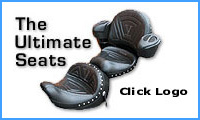|
Jess from VA
|
 |
« Reply #5 on: January 14, 2017, 03:44:11 PM » |
|
Do not forget to trash the OE valve stem and replace it with an all metal one.
If there is not time to get an all metal one, get a new OE one, and make sure the plastic elbow is still in there. When the wheel is off, push the OE stem to the side to see if it is cracked yet (it is only a matter of time). Try not to crack it when checking for cracks.
You will need a 27mm socket for the axle (I think that's it, but my memory is not what it was). This is best in half inch drive. A big honkin flat tip screwdriver to pry the halves apart, at the dust cover slot.
A few cans of brake cleaner or carb gummout (better), small stiff bristle brushes and a pile of rags helps with the cleanup, considerably. (eye protection with the spray too) This is where I learned nitrile gloves do a nice job in protecting your hands (not from bangs and cuts, but from chemicals).
The best greases are Guard Dog and Belray (waterproof).
Rear end dope (one small bottle, synthetic, 75-90 or 80-90).
A strong back is also helpful.
Look up inside the fender with a lite when wheel is out, to be sure no wiring is rubbed or moved or loose.
A good idea to use a jack stand under one or both engine guards, in addition to the bike jack. When the wheel comes off, she gets light in back real quick and can start to fall forward on the jack. This is not the good kind of excitement.
I take my axle out over the pipes like Mike (with the shocks off). During the process, the bike needs to go up a bit up and down a bit, several times. I don't use my jack safety bar at each move (or adjust the jack stands each time), but once the wheel is ready to come off, then stick the stands under the guards, and set the jack safety bar.
Hang the brake caliper on a coat hanger (or something), not on the hydraulic lines.
When putting it back together, feed the axle all the way through the wheel (wheel spacer) and caliper, but leave the caliper spacer donut out. This greatly assists in lining up the wheel to pumpkin square to be shoved back together with the weight held by the axle, and not your back. Once it's mated up nicely, then slide the axle back out just enough to replace the caliper spacer.
I also have to look around to make sure there are no children around, since when I do this job, it always (eventually) involves some amount of colorful language (at various volumes).
PS: Please look up and watch the power point by ChrisJ on the rear end service in Shoptalk. It's the best advice there is. Dags little video is nice, but it is quite abbreviated, and fails to cover about 20 little parts of the actual work (no offense intended Dag).
PSS: Assuming you are getting the tire put on at a shop, never forget to check they put it on with the arrows pointed in the right rotation direction. Nothing will cause colorful language like discovering this after you have it all reassembled on the bike.
|






